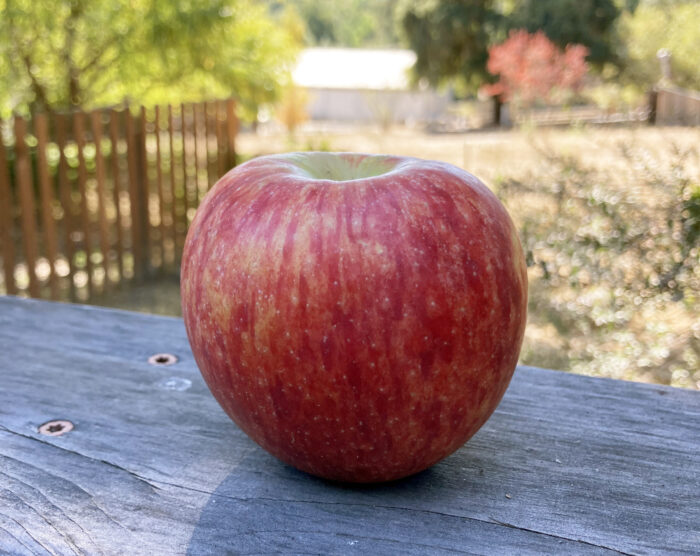
The modern cider enthusiast tends to think of England when the subject of famous apples for cider comes up, but the United States has had its fair share as well. Harrison. Hewe’s Virginia Crab. Campfield. Hagloe Crab. Most had all but disappeared from American orchards by the early 20th century. Winesap is an exception, still grown and relished today.
It originated some time in the 18th century, possibly on land owned by the Coles family in West Jersey who had been farming there since Samuel Coles arrived in the area around 1678. One of his descendants, another Samuel Coles, was noted as growing Winesap in the first mention of it found in print, A.F.M. Willich’s Domestic Encyclopedia, v.3, updated to include American apples by James Mease in 1803, where it is listed as Wine-sop. “Makes an excellent cyder, preferred by some to that of the red streak,” wrote Mease. “. . . the cider produced from it is vinous, clear, and strong; equal to any fruit liquor of our country for bottling,” noted William Coxe in A View of the Cultivation of Fruit Trees, and the Management of Orchard and Cider (1817).
The reference to wine in its name is an immediate clue to the high regard in which Winesap was held. From the 17th century on, cidermakers were always excited to find an apple that they believed made “vinous” cider, cider that was as rich and flavorful as the wines they knew. The early 19th century American horticultural writers made frequent comparisons between cider and wine, apples and grapes. Coxe wrote, “I have Cider of 1810 the mixture of Crab and Harrison and Winesap . . . which annually improves like the finest wines.” In a piece on cider apples written for The New England Farmer in 1826, Judge Jesse Buel said, “[t]he quality of cider depends upon the apples from which it is manufactured–the soil and location where they grow–and the process of manufacturing. When the two first are favourable, and the last well conducted, the product will be a fine racy liquor, superior for the table to the common wines of France, Spain, and Italy, and will keep as well as them.”
Change was afoot, however, as the demographics of the country shifted from mostly rural and agricultural to industrial centers in rapidly growing cities. Waves of immigrants from places where cider was not the drink of choice–Germany, Italy, Poland–shifted the American palate toward other beverages such as beer that could be cheaply made on an industrial scale. As tastes changed, so did the roll of apples. Farmers still made cider (which didn’t get manufactured on a large scale until the 20th century), but they increasingly focused on producing fruit for the fresh market. Winesap, as it happened, fit perfectly in that niche, too.
Tannin gets talked about a lot in today’s cider circles. It adds body and fullness to a cider (and wine) as well as being one of the chemical components that will help it keep well over time (acid is important, too). Cidermakers of the past eras recognized this, however for them the most important attribute of a cider apple wasn’t tannin but a rich concentrated flavor and plenty of sugar. “The only artificial criterion employed to ascertain the quality of an apple for cider, is the specific gravity of its must . . . This ensures to the liquor, strength . . .” explained Buel (New England Farmer, v5, no. 33, 1827). Winesap had both sugar and complexity of flavor. What saved it from obscurity, though, was the other things it brought to the table: red color, a good size and texture, mid- to late-ripening time (so it tended to keep well), and not having much in the way of tannin.
Winesap’s popularity as a fresh market apple, and the ability to grow well in many climates and soil types, helped it to find a place in commercial orchards from coast to coast by the mid-19th century. Its reputation also led to the proliferation of other, sometimes related, apples bearing the Winesap name: Winesap of the West, Winesap Start Double-Red, and Stayman Winesap among them.
As it is still widely grown today, it is possible to find any number of Winesap ciders made in different parts of the U.S. The examples I tasted through recently, though, were sometimes so divergent in strength and complexity that I had to wonder if they had truly been made with the same variety. What is more likely, though, is what Buel observed almost two centuries ago, that the manner in which an apple is grown can have a profound impact on the nature of the cider that apple will produce. The needs of the fresh market may not always jibe with those of the cidermaker.
Potter’s Craft Cider Pelure, Charlottesville, VA – dry; bay leaf, dried apple, apple, skin, pear, lemon, nutmeg, just ripe apricot, toast; sparkling; 2019; 9% ABV
Manoff Market Cidery Winesap, New Hope, PA – dry; apple, apple skin, peach, sweet lemon; sparkling; 2019; 6.6% ABV
Lassen Traditional Cider Paradise Strong, Chico, CA – dry; apple skin, plum, plum skin, bread dough, VA; sparkling; 2019; 7.5% ABV
Lassen Traditional Cider Winesap, Chico, CA – dry; ripe apple, just ripe peach, pear, plum skin, just ripe pineapple; sparkling; 2016; 8.1% ABV
Lassen Traditional Cider Winesap, Chico, CA – dry; mint, pear skin, oak, dried pineapple, peach, yellow apple, orange juice; sparkling; 2019; 8.1 ABV
Liberty Ciderworks Winesap, Spokane, WA – semi-dry; ripe apple, lemon juice, pineapple, pear, nutmeg, peach, vanilla; sparkling; 2017; 9.0 ABV